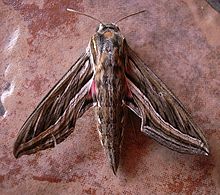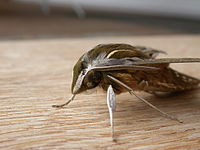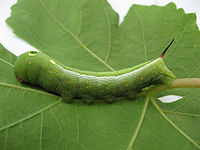- Hippotion celerio
-
Hippotion celerio 

Scientific classification Kingdom: Animalia Phylum: Arthropoda Class: Insecta Order: Lepidoptera Family: Sphingidae Genus: Hippotion Species: H. celerio Binomial name Hippotion celerio
(Linnaeus, 1758)[1]Synonyms - Sphinx celerio Linnaeus, 1758
- Sphinx tisiphone Linnaeus, 1758
- Phalaena inquilinus Harris, 1780
- Elpenor phoenix Oken, 1815
- Deilephila albolineata Montrousier, 1864
- Hippotion ocys Hübner, 1819
- Hippotion celerio unicolor Tutt, 1904
- Hippotion celerio sieberti (Closs, 1910)
- Hippotion celerio rosea (Closs, 1911)
- Hippotion celerio pallida Tutt, 1904
- Hippotion celerio luecki Closs, 1912
- Hippotion celerio brunnea Tutt, 1904
- Deilephila celerio augustii (Trimoulet, 1858)
Hippotion celerio, known as the Vine Hawk-Moth or Silver-striped Hawk-Moth, is a moth of the Sphingidae family. It is found in Africa, Southern Europe, Central and Southern Asia and Australia. It can be found further north, because of its migratory nature.
Contents
Colouring and marks
The body and forewing of the adult moth are green and ochre. They have silvery white dots and streaks, with a silvery band running obliquely on the forewing. The hindwing is red near its lower angle (tornus) to pinkish over other parts of the wing. It is crossed by a black bar and black veins.
Hippotion aphorodes may be only a very dark subspecies of celerio - in this form, the silvery streak on the forewing is not present but other markings are intensified. In addition, the hindwing is mainly brownish.
Size
The forewing is typically 28–35 millimetres (1.1–1.4 in) long.
Larva
Larvae may be green, yellowish green or even brown. They have a dark broken mid-dorsal line and a creamy dorso-lateral line from the fifth segment to the horn. The head is round, and usually a dull green colour. The larva has a horn which is usually long and straight. There is a large yellow and green eyespot on the third segment and a smaller one on the fourth segment.
Larvae typically feed on the leaves of plants such as the grape vine, Cissus, Impatiens and the Arum lily.
Other
William Monad Crawford is the only person to record this species in Northern Ireland.
References
- ^ "CATE Creating a Taxonomic eScience - Sphingidae". Cate-sphingidae.org. http://www.cate-sphingidae.org/taxonomy/Hippotion/celerio.html. Retrieved 2011-10-25.
- Pinhey, E. (1962): Hawk Moths of Central and Southern Africa. Longmans Southern Africa, Cape Town.
This Macroglossini-related article is a stub. You can help Wikipedia by expanding it.



